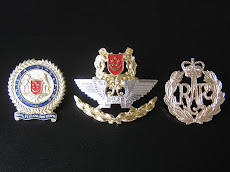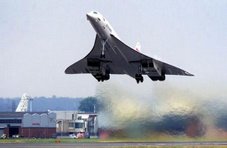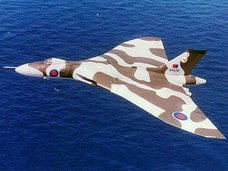>> Changi's rich aviation heritage
by Derek Yeo - SINGAPORE - 31 July 2006
CHANGI means many things to many people.
To Singaporeans and travellers worldwide, the name points to the famous airport. To thousands of Commonwealth veterans - especially former prisoners-of-war - the name conjures images of the infamous prison camp in World War 2 and of the hardship they endured. And certainly of Changi Chapel. To many former Royal Air Force (RAF) service personnel, it was the exotic Far East posting of their lives in the 1940s, 50s and 60s.
RAF Station Changi was home to Britain's Headquarters, Far East Air Force. Its area of command covered RAF Gan in the Indian Ocean, RAF Kai Tak in Hong Kong, RAF Labuan in Borneo and two other stations in Singapore: Seletar and Tengah. Changi played crucial roles in the Malayan Emergency 1948 -1960, Indonesian Confrontation 1963 - 1966 and Brunei Revolt 1963.
I too, have fond memories of Changi. During my service with the RAF in the sixties, I visited the station on many occasions. It was an uncertain period for newly-independent Singapore. Indonesian President Sukarno had just embarked on a campaign to confront Malaysia and Singapore.
Pop's canteen on the hill next to the camp entrance at Tangmere Road was a favourite stop for coffee. The Sergeants Mess at Old Sarum Road, a well-known landmark, served essential living, catering and social needs for British airmen. Rustic Changi Village and the beach were popular haunts with servicemen and their families.
The roads in the station bore, even to this day, names of famous RAF airfields in the UK, such as Cranwell, Wittering, Netheravon, Leuchars, Catterick and Andover.
I spent half a year at the old RAF hospital recovering from an urgent surgery. Squadron Leader Chapman-Andrews, the dental surgeon in charge of my operation, did a professional job. The medical treatment and care given me, suffice to say, was excellent.
In the 1970s, I had the opportunity again of living and working in Changi. By then, I had joined the Republic of Singapore Air Force. My unit, 120 Squadron (equipped with Alouette III helicopters) had moved to the Changi dispersal (off Telok Paku Road) from its original base at Seletar airbase. The British had handed over the entire Changi airfield intact to Singapore in 1971.
Now, a retired airman, Air Commodore Henry Probert, has published "The History of Changi" in collaboration with Changi Museum and the RAF Changi Association.
The book was launched on the 28 July 2006 at Changi Museum by Singapore's Minister of Transport and Second Minister of Foreign Affairs, Mr Raymond Lim.
What the Japanese built in World War 2, then developed by Britain as her premier air base in the Far East has come full circle. In 1981, after a decade as an RSAF air base, Changi replaced Paya Lebar Airport as Singapore's premier civil airport.
Singapore Changi Airport, as it is now officially known, showcases all that are "uniquely Singapore" around the globe.
Copyright © 2007 - 2008 A I R M E News. All rights reserved.
Monday, July 31, 2006
Wednesday, July 26, 2006
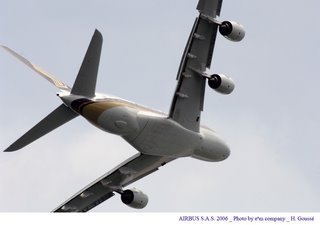
>> Singapore Airlines orders more Airbus A380s
by Singapore Airlines A380 Team - SINGAPORE - 25 July 2006
SINGAPORE Airlines is pleased to announce that it will be purchasing nine additional Airbus A380-800s as part of a deal worth US.5 billion at catalogue prices. As part of the purchase, the airline has options for another six A380-800s. These additional purchases of the superjumbo reflect the airline's confidence and clear commitment to the A380 programme.
"Airbus has demonstrated to Singapore Airlines' satisfaction that the engineering design of the A380 is sound. It has performed well in flight and certification tests, and the delays in its delivery have been caused more by production, rather than technical, issues.
"This latest order including 20 A350 XWB-900s and 20 Boeing 787-9s ordered in June, will position the Airline well for future growth and uphold our policy of continuous fleet renewal and modernisation," Singapore Airlines Chief Executive Officer, Mr. Chew Choon Seng said.
With this order, Singapore Airlines will have 19 firm orders and 6 options for the Airbus A380. Deliveries of all 19 A380s will commence in December 2006 and run until 2010.
Airbus' partnership with Singapore Airlines dates back to 1979, when the airline placed its first order for the A300-B4. In February 2004, the carrier launched non-stop operations with its ultra long-range A340-500s between Singapore and Los Angeles. With these flights, Singapore Airlines became the first airline to operate the world's longest commercial non-stop flight. The airline surpassed the record later that year with an even longer non-stop flight of 18 hours 18 minutes on the 9,000-nm/16,600-km route between Singapore and New York (Newark).
Stay tuned as the airline looks forward to continuing its tradition of historical firsts when it becomes the first airline to fly the world's largest passenger aircraft.
SOURCE: Singapore Airlines A380 News, issue 05/06; PHOTO: Airbus SAS
Posted by
Derek Yeo
on
Wednesday, July 26, 2006
0
comments
![]()
Friday, July 21, 2006
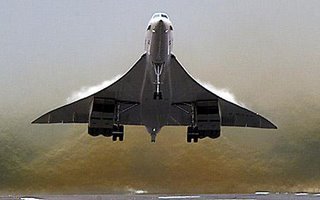
>> CONCORDE: Lest we forget
by Derek Yeo - SINGAPORE - 21 July 2006
"CONCORDE was born from dreams, built with vision, and operated with pride." - Capt Mike Bannister, before he flew British Airways' Flight BA002, New York to London, the final Concorde scheduled passenger service on 24 Oct 2003.
AIR FRANCE Concorde F-BTSC (Airframe No 203), departed Paris almost six years ago, on 25 July 2000, outbound for New York on a charter flight. It did not make it. Sixty seconds into the take-off, the supersonic jet crashed tragically near Charles De Gaulle airport.
All on board died. The 113 fatalities included 100 passengers, two pilots, a flight engineer and six cabin crewmen. Four people, in a hotel at the crash site, also perished.
The tragedy followed a chain of events. A piece of metal strip caused a tyre blow-out on the main landing-gear during the Concorde's take-off. Rubber shrapnel from the blow-out ruptured a fuel tank. Then, in its last moments in flight, fire broke out and two engines failed. Investigations revealed too, that the aircraft's take-off weight had been excessive.
After the crash, despite major modifications embodied on the remaining fleet, Concorde was soon retired. Escalating costs could not sustain keeping the fleet airworthy and in service any longer.
Although the fleet of 16 production aircraft had flown for 27 years since passenger services began on 21 Jan 1976, the fleet was still young when services ended in 2003. In maintenance, repair and overhaul terms, with only 2 airlines flying 14 Concordes between them - and not all serviceable at any time - the type proved costly over its service life to sustain.
Revenue dropped as astronomical fares on the trans-Atlantic routes kept passengers away. Low passenger load per flight - Concorde's capacity is just 100 passengers in a single "luxury" class - added to its problems.
A Soviet Union's Tupolev Tu-144 supersonic passenger jet - dubbed "Concordski" in Russian - tragically crashed at the 1973 Paris Air Show. In terms of promoting commercial supersonic travel, the Tu-144's disaster proved detrimental to Concorde's image. It was not, however, the only Tu-144's setback.
Having begun cargo service in 1975, then regular passenger service a year on, the type finally ceased flying in 1983 because of technical failures.
An aeronautical marvel no doubt, Concorde was ahead of its time. Its ogival delta-shaped wing, for instance, designed for supersonic flight was a first for a passenger airliner. Only one other aircraft had the same shaped wings: the British AV Roe's Vulcan nuclear bomber. At Mach 1 to 2 speed, the Concorde's heat-treated skin registered a constant 127 degrees Centigrade temperature.
No passenger jets matched Concorde in aeronautical terms. In the sky, Concorde was an icon of grace and power. It represented man's greatest endeavour in commercial aviation.
But commercially, it became apparent to Concorde's makers, British Aircraft Corporation and Aerospatiale, and to Air France and British Airways that the type had become increasingly unviable. Maintenance, repair and overhaul (MRO) costs escalated. With a fleet of only 16 production aircraft - and not all airworthy - Concorde's upkeep proved costly over its short service life.
Only French and British national prestige kept Concorde airborne. Perhaps, Concorde's very own advanced technology sounded its death knell.
That tragic event in July 2000 help hastened the end of the world's only supersonic airliner.
Concorde scheduled passenger service began on 21 Jan 1976. On 24 Oct 2003, British Airways' Concorde Flight BA002 departed New York's JFK Airport on its last scheduled airline service. Sadly, when BA002 touched down at London's Heathrow Airport two hours later, 27 years of sterling airline service landed too. The Concorde era had ended.
Copyright © 2007 AIRMENews. All rights reserved.
Posted by
Derek Yeo
on
Friday, July 21, 2006
0
comments
![]()
Labels: British Airways, Concorde, supersonic jet
Tuesday, July 11, 2006
>>> Sibir Airlines Flight 778
- Airbus SAS press statement - TOULOUSE
AIRBUS regrets to confirm that an A310-300, operated by Sibir Airlines, was involved in an accident shortly before 03.00 h local time at Irkutsk, Russia. The aircraft was operating a scheduled service, Flight 778, from Moscow to Irkutsk. Unconfirmed reports indicate that there were 200 passengers and crew on board. At this stage, the number of casualties is not yet known. Unconfirmed media reports suggest that there are 40 survivors.
The aircraft involved in the accident, registered under the number F-OGYP, was MSN (Manufacturer Serial Number) 442, delivered from the production line in June 1987. The aircraft had accumulated more than 59,000 flight hours in more than 10,000 flights. It was powered by Pratt & Whitney PW4152 engines. At this time no further factual information is available.
In line with international convention, Airbus will provide full technical assistance to the Authorities, who will be responsible for the investigation into the accident. A team of specialists from Airbus is being dispatched to Russia.
The A310-300 is a twin-engine widebody aircraft seating 220 passengers in a standard two-class configuration. The first A310-300 entered service in December 1985. By the end of June 2006, 229 A310 aircraft were in service with 39 operators. To date, the entire fleet has accumulated some 10,5 million flight hours in more than four million flights.
Airbus will make further factual information available as soon as the details have been confirmed. However, the investigation remains the entire responsibility of the relevant authorities and it would be inappropriate for Airbus to enter into any form of speculation into the cause of the accident.
The concerns and sympathy of the Airbus employees go to the families, friends and loved ones affected by the accident of Flight Sibir Airlines 778.
For further information, please contact:
AIRBUS - MEDIA RELATIONS
Tel.: (33) 05.61.93.33.87 or 05.61.93.34.31
Posted by
Derek Yeo
on
Tuesday, July 11, 2006
0
comments
![]()

>>> Singapore evaluates next trainer-jet
by Derek Yeo-SINGAPORE-Tue 11 Jul 2006
COUNTRIES in South-east Asia and farther afield eagerly awaits Singapore's next choice of its basic fixed-wing trainer-aircraft. The city-state's selection will be a bench-mark for other customers to evaluate the various contenders.
Prospective customers such as Thailand, the Philippines, Turkey and Chile are also considering replacements for their ageing air force training jets.
Currently, four contenders: Raytheon T-6B, Aermacchi M-311, Pilatus PC-21 and Embraer Super Tucano, are in the race for the Singapore procurement.
Interestingly, the Aermacchi M-311 (see photo) has a Singapore link. Its predecessor, the Marchetti S-211, is reaching the end of its long service in the Republic of Singapore Air Force (RSAF). The S211, despite its poor sales in the fixed-wing jet-trainer market, has served RSAF creditably and fulfilled its training role.
Copyright © 2007 AIRMENews. All rights reserved.
Posted by
Derek Yeo
on
Tuesday, July 11, 2006
0
comments
![]()
